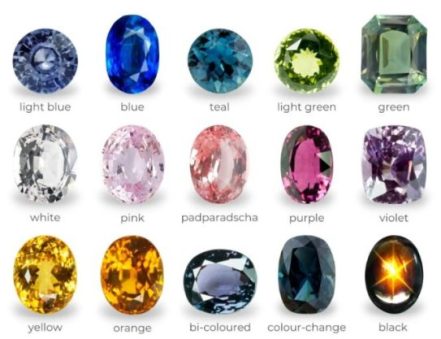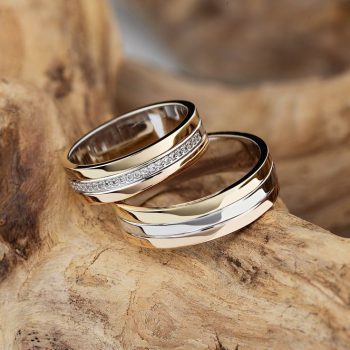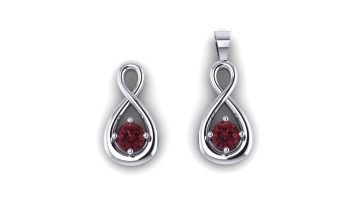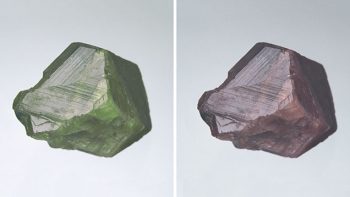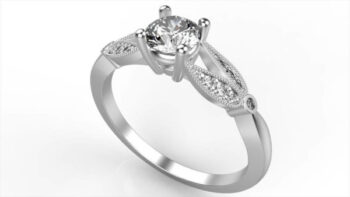How To Buy A Sapphire
Whether you want the standard blue, green, or pink, sapphires can be difficult to purchase. There is no standard clarity or color grading system like there is for diamonds. There is also price list like the rappaport report for diamonds, which doesn’t exist for colored stone. Consequently, prices are all over the place and are very subjective. This can cause confusions as to why some stones cost more than others, even if they look the same to the eye. It is almost as if prices are set based on how much the seller thinks he can get someone to pay.
There is also the personal preference aspect of choosing a colored stone. Some might like the deep royal blue. While others might love the light, cornflower blue. Some people don’t want blue stones at all! Then, you have natural vs lab sapphires and heated vs unheated. There are also lattice diffused sapphires. So we understand why the question of How To Buy A Sapphire is a common one.
You can find sapphires everywhere. Amazon, Ebay, and Etsy all have sellers hawking sapphires. Every jewelry store sells sapphires as well. Then, there are specialty gemstone sellers who sell very high priced sapphires. The variety of offerings alone is staggering. You have lab stones. Then, you have stones ranging from opaque pebbles to stunning, unheated, royal blue gems. This guide will help you in your search for a sapphire and hopefully will save you some money while making it easier. Note that we are only dealing with blue sapphires here. The other colors deserve their own post as a group.
How To Buy A Sapphire – Color

Blue sapphire is a gemstone that captivates with its mesmerizing color spectrum. Ranging from deep midnight blue to vibrant cornflower blue, this gemstone offers a wide range of shades that are sure to catch the eye. The color spectrum of blue sapphire is truly a sight to behold, making it a popular choice for jewelry enthusiasts and collectors alike. Whether you prefer a rich, intense blue or a lighter, more ethereal hue, blue sapphire has something to offer for everyone.
One of the things we love about the blue sapphire color spectrum is its versatility. The deep, dark blues exude a sense of mystery and elegance, perfect for a glamorous evening out. On the other hand, the lighter shades of blue have a delicate and ethereal quality that is simply enchanting. Whether you’re looking for a statement piece or a subtle touch of color, blue sapphire has you covered.
Blue sapphire color plays a significant role in determining its value. The most valuable blue sapphires are those with a vivid, intense blue hue. These stones are highly sought after due to their striking color, which is often compared to the deep blue of the ocean or the evening sky. The presence of secondary colors, such as purple or green, can affect the value of a blue sapphire. However, a well-balanced combination of these secondary colors can enhance the overall beauty of the stone, making it more desirable to collectors and buyers.
When it comes to blue sapphires, color consistency is also important. Stones with an even distribution of color throughout are considered more valuable than those with uneven color zoning. This means that a blue sapphire with a uniform blue hue, without any noticeable variations or patches of lighter or darker shades, will command a higher price in the market.
How To Buy A Sapphire – Saturation
Color saturation is Color saturation is the intensity and purity of a color as displayed in a colored gemstone. Blue sapphire color saturation is also a key factor in determining the quality and value of this precious gemstone. The saturation refers to the intensity or depth of color present in the stone. A highly saturated blue sapphire will have a rich, vibrant hue that is visually striking and captivating. This is often considered more desirable and valuable compared to a sapphire with lower saturation levels. In my opinion, a blue sapphire with high color saturation not only looks more visually appealing, but also exudes a sense of luxury and elegance. It is definitely a gemstone that can make a statement and add a touch of sophistication to any piece of jewelry.
When it comes to evaluating the color saturation of a blue sapphire, experts consider factors such as hue, tone, and saturation level. The hue refers to the actual color of the sapphire, which can range from a deep royal blue to a lighter, more pastel shade. The tone refers to the darkness or lightness of the color, with medium tones often being the most desirable. Finally, the saturation level determines the intensity of the color. A blue sapphire with high saturation will have a vivid and intense color that is sure to catch the eye.
In our experience, blue sapphires with high color saturation are often the most sought after by collectors and enthusiasts. The richness and depth of color in these gemstones make them truly stand out from the crowd. On the other hand, there are those that prefer the less saturate cornflower blue color. It really boils down to personal preference.

How To Buy A Sapphire – Transparency
Blue sapphire transparency plays a significant role in determining its price. The transparency refers to how light passes through the gemstone. The more transparent the sapphire, the higher its value. Transparent sapphires allow light to pass through easily, creating a brilliant sparkle and enhancing its overall beauty. On the other hand, opaque or heavily included sapphires may appear dull and less desirable. Therefore, when buying a blue sapphire, it is essential to consider its transparency to ensure you get the best value for your money.
In terms of price, transparent blue sapphires are generally more expensive than those with lower transparency. This is because transparent sapphires are rarer and more sought after by collectors and jewelry enthusiasts. Their ability to reflect light and exhibit a vibrant color makes them highly desirable. As a result, transparent blue sapphires often command higher prices in the market.
However, it is important to note that the price of a blue sapphire is not solely determined by its transparency. Other factors such as color, cut, and carat weight also play a role in its value. A high-quality blue sapphire with excellent transparency, combined with a deep and vivid blue color, precise cut, and significant carat weight, will be more valuable than a transparent sapphire with a less desirable color or cut.
How To Buy A Sapphire – Clarity
When it comes to blue sapphires, clarity plays a significant role in determining their price. The clarity refers to the presence of any internal or external flaws, known as inclusions and blemishes, respectively. The fewer the flaws, the higher the clarity grade, and consequently, the higher the price. A blue sapphire with excellent clarity will have minimal inclusions or blemishes, making it more valuable and desirable.
The clarity of a blue sapphire is assessed using a grading system that ranges from “eye-clean” to “included.” An eye-clean sapphire means that the flaws are not visible to the naked eye, while an included sapphire has noticeable flaws. The clarity grade is determined by the size, number, and visibility of these flaws. It is important to note that even sapphires with inclusions can still be stunning and have unique characteristics.
In general, blue sapphires with higher clarity grades command higher prices in the market. This is because sapphires with excellent clarity are rare and more visually appealing. Buyers are willing to pay a premium for a blue sapphire that is free from visible flaws. However, it is essential to strike a balance between clarity and other factors such as color and cut. While a flawless sapphire may be highly valuable, it may lack the vibrant blue color or the ideal cut that enhances its beauty.
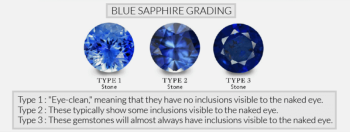
How To Buy A Sapphire – Shapes & Cuts
Blue sapphires come in various cuts and shapes, and these factors can greatly influence their price. The cut refers to how well the gemstone has been shaped and faceted, while the shape refers to the overall outline of the stone. Both of these aspects play a significant role in determining the value of a blue sapphire.
When it comes to the cut, a well-executed cut can enhance the brilliance and sparkle of a blue sapphire, making it more visually appealing. A poorly cut sapphire, on the other hand, may lack luster and appear dull. Consequently, a well-cut blue sapphire will generally command a higher price due to its superior visual impact.
In terms of shape, there are several popular options, including round, oval, pear, and cushion. Each shape has its own unique charm and appeal. Round sapphires, for instance, are classic and timeless, while oval sapphires offer a more elongated and elegant look. The choice of shape ultimately comes down to personal preference, but it’s worth noting that certain shapes may be more in demand, which can affect their price.
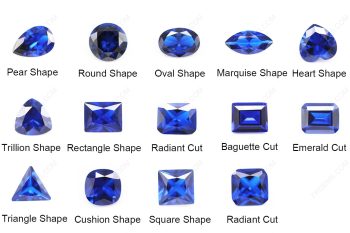
How To Buy A Sapphire – Symmetry
Symmetry plays a significant role in determining its price. Symmetry refers to the alignment and arrangement of the gemstone’s facets. A well-cut sapphire with excellent symmetry reflects light evenly, resulting in enhanced brilliance and sparkle. This makes it more visually appealing and desirable to buyers. In contrast, a sapphire with poor symmetry may appear dull and lackluster, diminishing its value. Therefore, when purchasing a blue sapphire, it is crucial to consider its symmetry to ensure you get the most value for your money.
Not only does symmetry affect the visual appeal of a blue sapphire, but it also impacts its overall quality. A well-cut sapphire with symmetrical facets allows for better light dispersion, which creates a mesmerizing play of colors known as the sapphire’s “fire.” This captivating display of colors adds to the gemstone’s allure and increases its value. On the other hand, a sapphire with asymmetrical facets may result in light leakage, diminishing the gemstone’s fire and reducing its desirability.
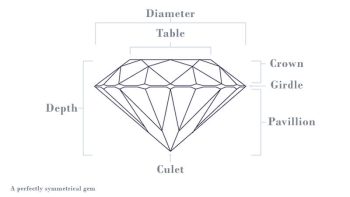
How To Buy A Sapphire – Weight & Size
Blue sapphires come in a range of weights and sizes, and these factors can greatly affect the price. Generally, larger and heavier blue sapphires are more valuable than smaller ones. This is because larger stones are rarer and require more resources to mine and cut. Additionally, larger stones tend to have a more intense and vibrant color, which is highly sought after by collectors and enthusiasts. Therefore, if you’re looking to invest in a blue sapphire, it’s worth considering the weight and size of the stone to ensure you’re getting the best value for your money.
However, it’s important to note that the price of blue sapphires is not solely determined by weight and size. Other factors, such as the quality of the stone, its color, clarity, and cut, also play a significant role in determining its value. A smaller, high-quality blue sapphire with exceptional color and clarity can be more valuable than a larger stone of lower quality. So, it’s essential to consider these factors in conjunction with weight and size when assessing the price of a blue sapphire.
How To Buy A Sapphire – Stone Origin
Blue sapphires have a fascinating origin that greatly impacts their price. These precious gemstones are formed deep within the Earth’s crust under intense heat and pressure. The presence of trace elements such as iron and titanium gives them their distinctive blue color. The rarity of blue sapphires, combined with their stunning beauty, makes them highly sought after in the jewelry market. In my opinion, their origin and unique characteristics contribute to their allure and justify their higher price compared to other gemstones.
The origin of blue sapphires plays a crucial role in determining their value. Sapphires are typically found in countries like Sri Lanka, Myanmar, and Madagascar, where they are mined from ancient deposits. The geological conditions in these regions create the perfect environment for the formation of blue sapphires. The scarcity of these gemstones due to limited mining locations adds to their exclusivity and drives up their price.
Furthermore, the color of blue sapphires is influenced by the presence of certain elements during their formation. The presence of iron gives them a deep blue hue, while titanium creates a lighter blue shade. The intensity and saturation of the blue color greatly affect the value of the sapphire. The more vibrant and vivid the blue, the higher the price. This unique coloration sets blue sapphires apart from other gemstones and makes them highly desirable among collectors and jewelry enthusiasts.
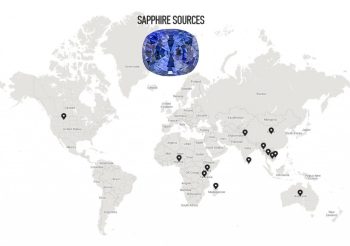
How To Buy A Sapphire – Treatments
It is important to understand that not all blue sapphires are created equal. Many blue sapphires undergo treatments to enhance their color and clarity, which can have a significant impact on their price.
One common treatment for blue sapphires is heat treatment. This process involves heating the gemstone to high temperatures to improve its color and remove any impurities. Heat treatment is widely accepted in the industry and is considered a standard practice. It can enhance the blue hue of a sapphire, making it more vibrant and desirable. However, it’s worth noting that heat-treated sapphires may be less valuable than untreated ones. Despite that, the majority of stones you see on the market will have been heat treated. Do not trust even a certified stone’s unheated claim unless it is from GIA or AGS.
Another treatment that is sometimes used on blue sapphires is diffusion treatment. This process involves adding certain elements to the surface of the gemstone to enhance its color. While diffusion treatment can create stunning blue sapphires, it is generally considered less desirable in the market. This is because the color enhancement is not natural and can fade over time, affecting the overall value of the gemstone.
How To Buy A Sapphire – Certificates
Blue sapphires are a popular gemstone known for their stunning blue color. When it comes to purchasing a blue sapphire, certification plays a crucial role in determining its price. Certified blue sapphires are those that have been evaluated and graded by reputable gemological laboratories. This certification provides buyers with assurance regarding the quality and authenticity of the gemstone. However, that does not mean that all certification labs are good. Most aren’t. We would only recommend trusting GIA or AGS for colored gemstones.
The certification process involves assessing various factors such as color, clarity, cut, and carat weight. These factors contribute to the overall value and rarity of the blue sapphire. A certified blue sapphire with excellent color, high clarity, and a well-cut shape will typically command a higher price compared to a non-certified stone.
Furthermore, certification adds a layer of transparency and trust to the buying process. It allows buyers to make informed decisions based on the objective grading provided by the gemological laboratory. This helps prevent the purchase of counterfeit or misrepresented blue sapphires, ensuring that buyers get what they pay for.
The Bottom Line
When it comes to buying a sapphire, there are a few key factors to consider. First, determine the quality of the stone by examining its color, clarity, cut, and carat weight. A vibrant blue hue with minimal inclusions is ideal. Next, decide on the shape and size that suits your preferences and budget. Keep in mind that larger sapphires tend to be more expensive. Finally, consider the source of the sapphire. Natural sapphires are typically pricier than lab-created ones. In terms of price, expect to pay anywhere from a few hundred dollars to several thousand, depending on the factors mentioned earlier. Ultimately, the choice is yours, so take your time and find a sapphire that speaks to you. Happy shopping!
It is important to be well-informed before making a sapphire purchase. By understanding the quality factors and considering your personal preferences, you can ensure that you’re getting the best value for your money. Don’t be afraid to ask questions and seek guidance from reputable jewelers. Remember, buying a sapphire is a personal investment, so take your time and choose wisely. With a little research and a touch of luck, you’ll find the perfect sapphire that will bring joy for years to come.
Buying a sapphire requires careful consideration of its quality, shape, size, and source. The price range can vary greatly depending on these factors, so it’s important to set a budget and stick to it. Remember, a beautiful sapphire doesn’t have to break the bank. By being informed and patient, you can find a stunning gemstone that fits your style and budget. So go ahead, dive into the world of sapphires and let their mesmerizing beauty captivate you.
Give Us A Try!
We make custom jewelry to order. That is all we do. So, unlike the chain and mall stores, we (you) pick each stone for each setting. That means you will get the stone you want and and best bang for your buck. You can view our portfolio of custom engagement rings or custom pendants to look for ideas. Or you can contact us about How To Buy A Sapphire.
